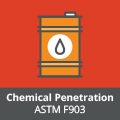Breathable Standards
Breathable Standards
When industrial workers must perform their job in foul weather, it certainly makes the job more difficult. Why then should that worker be uncomfortable as well? Traditional liquid-proof products not only keep liquid out but also keep the heat that your body produces while working contained inside the suit. The build up of heat then condenses and soaks back into your clothing where you end up soaking wet and uncomfortable.
Today, the breathable technologies that previously existed only in the recreation market now can be applied to products that are designed to protect against industrial hazards. This means that not only can you be safe but comfortable at the same time.
Breathability can be measured several ways. ASTM E96 measures the amount of moisture vapor that transmits through a material (MVTR). ASTM F1868 measures the ability of a material to release heat as it is built up, or Total Heat Loss (THL). Regardless of the method, the result yields a product that increases worker comfort without compromising safety.
Resource Info
| Related Standards | |
|---|---|
| Standard | Name |
| ASTM E 96-10 | Standard Test Methods for Water Vapor Transmission of Materials |
| ASTM E398-03 (2009)e1 | Standard Test Method for Water Vapor Transmission Rate of Sheet Materials Using Dynamic Relative Humidity Measurement |
| ASTM F1249-06 (2011) | Standard Test Method for Water Vapor Transmission Rate Through Plastic Film and Sheeting Using a Modulated Infrared Sensor |
| ASTM F1868-12 | Standard Test Method for Thermal and Evaporative Resistance of Clothing Materials Using a Sweating Hot Plate |
| F2298-03 (2009)e1 | Standard Test Methods for Water Vapor Diffusion Resistance and Air Flow Resistance of Clothing Materials Using the Dynamic Moisture Permeation Cell |
| ISO 11092:1993/Amd 1:2012 | Measurement of thermal and water vapor resistance under steady-state conditions (sweating guarded-hotplate test) |







